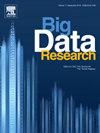Bankruptcy risk prediction: A new approach based on compositional analysis of financial statements
IF 4.2
3区 计算机科学
Q2 COMPUTER SCIENCE, ARTIFICIAL INTELLIGENCE
引用次数: 0
Abstract
The development of models for bankruptcy risk prediction has gained much attention in recent years due to the great availability of financial statement data. Most existing predictive models rely on financial ratios, which are performance-based measures expressing the relative magnitude of two accounting items. Despite the popularity of financial ratios, their use is notoriously accompanied by serious practical drawbacks, like the occurrence of outliers and redundancy, making data preprocessing necessary to avoid computational problems and obtain a good predictive accuracy. Isometric log ratios can potentially overcome these problems because they are designed to represent compositional data efficiently and have a logarithmic form that limits the occurrence of outliers. However, although they are not novel in the analysis of financial statements, no study has ever employed them to predict bankruptcy. In this article, we show the effectiveness of isometric log ratios to detect bankruptcy events in a sample of 138,720 Italian firms (127,420 active and 11,300 bankrupted) belonging to different industries and with different size and age. For this purpose, we use logistic regression with adaptive LASSO regularization and random forests to construct several predictive models featuring either financial ratios or isometric log ratios, and combining different horizons and lag structures. The results show that a set of 8 isometric log ratios provides, without preprocessing, almost the same predictive accuracy as a selection of 16 financial ratios that requires dropping 3.6% of the data. Also, the adaptive LASSO regularization reveals that redundancy for isometric log ratios is always below 20%, and in some cases near 0%, while it ranges from 12.5% to 46.9% for financial ratios. The predictive accuracy of models based on logistic regression is in line with and even higher than the one reported by recent studies, and random forests achieve a gain in the area under the Receiver Operating Characteristic (ROC) curve ranging between two and three percentage points.
破产风险预测:基于财务报表成分分析的新方法
近年来,由于财务报表数据的可获得性很大,破产风险预测模型的发展受到了广泛关注。大多数现有的预测模型依赖于财务比率,这是一种基于业绩的指标,表示两个会计项目的相对大小。尽管财务比率很受欢迎,但众所周知,它们的使用伴随着严重的实际缺陷,如异常值和冗余的出现,使得数据预处理成为必要,以避免计算问题并获得良好的预测准确性。等距对数比可以潜在地克服这些问题,因为它们被设计为有效地表示组成数据,并且具有限制异常值出现的对数形式。然而,尽管它们在分析财务报表方面并不新颖,但还没有研究使用它们来预测破产。在本文中,我们展示了等距对数比率在138,720家意大利公司(127,420家活跃公司和11,300家破产公司)中检测破产事件的有效性,这些公司属于不同的行业,具有不同的规模和年龄。为此,我们使用具有自适应LASSO正则化和随机森林的逻辑回归来构建几个具有财务比率或等距对数比率的预测模型,并结合不同的视界和滞后结构。结果表明,在没有预处理的情况下,一组8个等距对数比率提供的预测精度几乎与选择16个财务比率相同,这需要减少3.6%的数据。此外,自适应LASSO正则化表明,等距对数比率的冗余度始终低于20%,在某些情况下接近0%,而财务比率的冗余度在12.5%至46.9%之间。基于logistic回归的模型预测精度符合甚至高于近期研究报道,随机森林在受试者工作特征(ROC)曲线下的面积增加了2 - 3个百分点。
本文章由计算机程序翻译,如有差异,请以英文原文为准。
求助全文
约1分钟内获得全文
求助全文
来源期刊

Big Data Research
Computer Science-Computer Science Applications
CiteScore
8.40
自引率
3.00%
发文量
0
期刊介绍:
The journal aims to promote and communicate advances in big data research by providing a fast and high quality forum for researchers, practitioners and policy makers from the very many different communities working on, and with, this topic.
The journal will accept papers on foundational aspects in dealing with big data, as well as papers on specific Platforms and Technologies used to deal with big data. To promote Data Science and interdisciplinary collaboration between fields, and to showcase the benefits of data driven research, papers demonstrating applications of big data in domains as diverse as Geoscience, Social Web, Finance, e-Commerce, Health Care, Environment and Climate, Physics and Astronomy, Chemistry, life sciences and drug discovery, digital libraries and scientific publications, security and government will also be considered. Occasionally the journal may publish whitepapers on policies, standards and best practices.
 求助内容:
求助内容: 应助结果提醒方式:
应助结果提醒方式:


